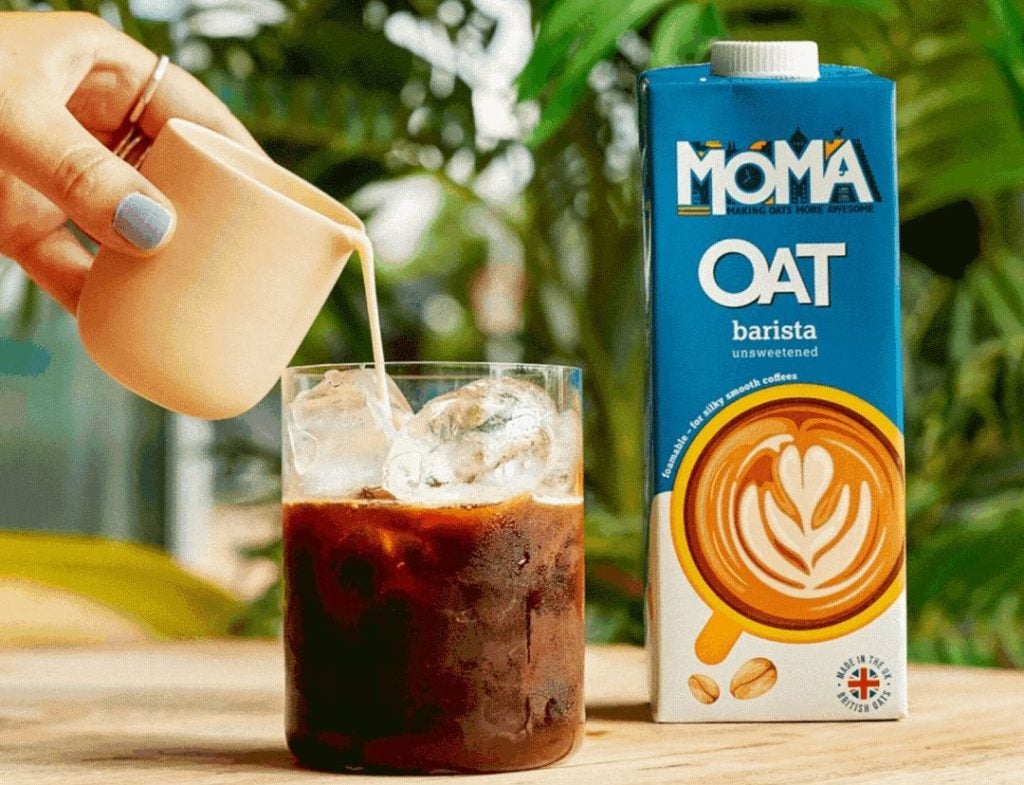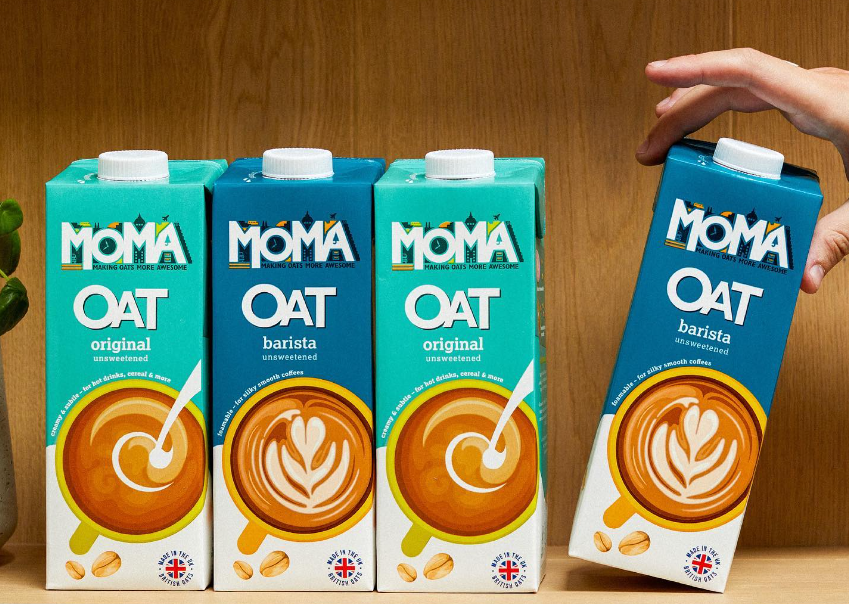As managing director for Moma Foods, Peter Joubert is at the top of the A.G. Barr-owned UK oat-milk business’ efforts to become a major player in the category. Founded in 2006, Moma moved into beverages in 2020, having started in breakfast foods, primarily offering porridges, cereal bars and mueslis.
When A.G. Barr first became the majority shareholder of Moma in late 2021, it said Moma oat milk was the third-largest brand in the category in the UK. The Irn-Bru brand owner snapped up the remaining equity stake in late 2022.
Just Drinks sat down with Joubert to hear about Moma’s growth plans in the UK plant-based beverage category, the future of the sector and why “being British” may help the brand stand apart from the competition.
Just Drinks: How’s life under A.G. Barr’s ownership and what’s changed since it took over?
Moma managing director Peter Joubert: I mean, in short, nothing’s massively changed, other than, with the support of A.G. Barr, we’re able to invest in growing faster, so they provide that financial support for us as a fast-growing British food brand. But we’re being run as an independently managed subsidiary of the group, which is great. So, I’m still staying on. I’ve been with Moma just under ten years now, MD for about six.
JD: Moma’s presence in plant-based beverages currently stands with a range of oat milks. How would you describe the category now?
PJ: Plant milk, having grown rapidly during a post-lockdown period, has seemed at the surface to dramatically slow down. Dairy alts is now growing at only 1% in the last 52 weeks to June looking at Nielsen data. However, oat within that category is still growing at 12%. Oat is the fastest growing sub-segment and it’s now the biggest segment as well in terms of ingredients. Oat now makes up 52% of the dairy-alts category in the UK.
We believe that oat is the future of the plant milk category, owing to its superior taste and better sustainability credentials. It is the place to be really. Ever since our inception, we’ve always been very oat-focused. We’ve got no plans to go into anything other than oats. We’ll just continue to innovate in the oat milk space and grow that.
And we’re leading the growth in the category. Moma has grown 53% in the last year, which is four times faster than the category at 12%. You look at other leading competitors like Alpro and Oatly: Alpro is -1% and Oatly is about +6%. They’ve fallen behind the wider oat milk category.
We’re still a relatively small player but we are on a mission to get oat milk into more baskets and more people’s cupboards across the UK. And our unique position of being the craft oats company is we really focus on taste and quality and being British. We are, I think, the only major brand that makes our own milk in the UK using British oats.

When we look at the market breakdown overall, we estimate as much as 97% of oat milk purchased in the UK is not made with British oats but with European oats, which just seems crazy to me. When this is a category where a big reason is to be better for the planet and more sustainable, it seems nuts to be making products or buying products that are using imported oats when it’s actually the crop we do grow a lot of on our shores.
That sustainability message is really important for the future growth of the category. Part of the reason almond and coconut milks are in declines is because they don’t have strong sustainability credentials, as well as not tasting or performing as well as hot drinks.
JD: When you talk about oat milk’s sustainability credentials, is that primarily to do with imports, ahead of anything further up the supply chain?
PJ: Well, it’s a low input crop, so it doesn’t compare to almonds. It’s widely publicised how many litres of water it takes to grow an almond. We can grow oats locally, that’s a really big part of it, yes, but they’re also crops that are just less intensive in terms of the inputs needed to grow them.
But, yes, if you assume they’re made very similarly in the UK versus made in the EU or further afield, that’s a huge saving of having to put them on lorries, heavy liquid and import them into the UK.
JD: You mentioned how you’re focusing only on oat milk. What are your plans to further grow sales over the next couple of years?
PJ: We’re innovating to bring more products to market. We’re continuing to work on our product quality to ensure we’re at the cutting edge. We believe we’ve got the best quality oat milk on the market and don’t want to just take that for granted. Now we want to keep working on innovation. We’re funding PhD research in this area to really understand oats in a lot more detail, through basically the experts in the field.
One thing to notice already is we make our oat milk through a kind of extraction method. We take oats, blend with water, add enzymes to make it more soluble and bottle it basically. However, a lot of products on the market are made using an oat syrup, which is actually also imported from the EU or further afield. It’s a bit like fresh versus concentrated orange juice.
It’s quite a difficult concept to explain or understand for a consumer but the reason our product is so much better quality, tastes so much better, foams better making a latte is that it’s made ‘fresh’, rather than making an oat base, distilling it into a thick syrup, sending it around the world and then it just be rehydrated and bottled there.
When you do that process, you lose a lot of the solid contents, all the natural proteins and fibres and the product’s taste profile completely changes as well. Our energies are focused on refining that oat extraction method and our unique kind of IP there to make sure we continue to have the best quality oat milk in the market.
JD: Is that extraction a method only Moma uses, as far as you’re aware?
PJ: No. I don’t know exactly [which others do] but Oatly, for example, do the same as us. They do an extraction method. It varies for other brands but, yes, they’re definitely not all created equal.
JD: While you said Moma’s oat milk is growing ahead of the curve at the moment, how would you say the business has been affected by cost inflation over the last 18 months or so?
PJ: I mean, probably as badly as everyone else, I’d say. There’s been a lot of inflation we’ve had to push through. Unfortunately, that’s just the reality. It does look to be slowing down but the hopes that there’d be some dramatic drop-offs in costs are not looking like they're likely anywhere on the horizon for the moment other than some reductions in energy surcharges. Unfortunately, I think the higher pricing is here to stay for a bit.
We’re hoping as a smaller challenger company if we can continue to grow ahead of the market, we will be able to access some economies of scale that we can then pass on to our shoppers because our ambition is very much to be the best quality but at accessible pricing. We want to bring new people into the category and we’re very pro-oat rather than kind of anti-opposition.
JD: Based on the growth that plant milk has seen, can you tell whether that’s driven through price increases on their own or are you still seeing the same volume of units being sold?
PJ: Data wise (Nielsen’s latest 52wk data to June) has Moma growing 56% in units and 53% in value, so we are managing to grow volume slightly ahead of value despite cost inflation pressure.
Overall, plant milks have slowed dramatically over the last year and that’s a challenge for category: to a degree, we need to do more to bring in the next wave of plant-milk users because that recruitment has slowed down. What is encouraging is oat is what’s growing within that but that's growing primarily, it seems, from switching people out of other inferior plant milks like almond, soy, coconut, rice, whatever it is.

It’s no surprise oat is growing. We think that’s pretty much the future of the category. It’s attracting attention and there’s more brands and more SKUs being made available. But the retailers, given the slowdown, seem to be range rationalising and the opportunities seem to be fewer. There’s a bit of a lull in performance in the category but this will check back up I think over the next year.
To get oat to continue growing and bringing more people in, I do think this British-made and quality is going to be really key to that because a big reason for choosing oat is the sustainability credentials for consumers.
JD: Do you think that would apply in other countries? For example, in the US, do you think there would be the same demand for US-made oat milk?
PJ: I think so, following the logic of the reason being used for choosing a product is because it’s more sustainable, better for the environment, low carbon emissions and all that. If you’re comparing it to dairy, then you’re going to import a product from overseas, it lessens that credibility really, so I think that’s an essential consideration. And, actually, maybe part of the reason we’re not particularly aggressively looking at international for now is we’re not in a position to be setting up factories all over the world yet and exporting products doesn’t feel like the most sustainable way to grow a sustainable category.
JD: You say that your main focus is the UK but do you see a bigger opportunity abroad over the next few years?
PJ: I’ve given up trying to predict beyond three years! For the immediate future, the focus is certainly the UK but we’ll continue looking at evaluating international opportunities.
JD: Could you give a bit more of a gauge of the UK’s presence in the oat milk game overall?
PJ: I think this is a weakness. We don’t produce much in the UK, both oat milk and plant milks generally. The biggest players like Alpro and Oatly, they’re produced overseas, [and] they make up the lion’s share of the market. They’re definitely made in Europe and imported to the UK.
But I think this will change and I think we’re a good example of that. Our investing in and focusing on UK production, which should improve quality, reduce cost and – with the right messaging to consumers – get more people buying the product. I think that other brands will follow suit.
[Link src="https://www.nridigital.com/just-drinks/" title="This article initially appeared in the August 2023 issue of Just Drinks’ quarterly digital magazine" font-size="20px"]








